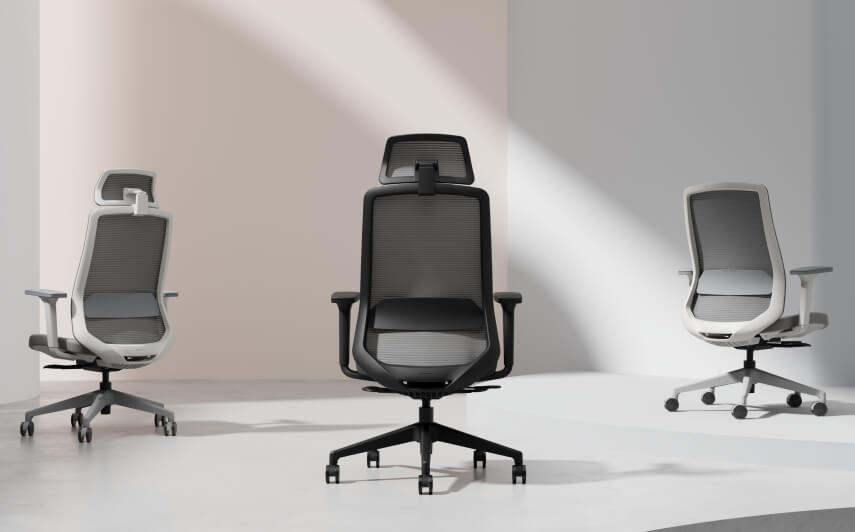
Introduction:
An Ergonomic Office Chair is more than just a seat; it’s a tool to promote comfort, proper posture, and productivity in the workspace. With the rise of remote work and long hours spent sitting, investing in an ergonomic chair is essential for reducing strain and preventing health issues. This guide explores the importance of ergonomic chairs, key features to consider, and how to select the right chair to support your workday.
Why Invest in an Ergonomic Office Chair?
An ergonomic chair is specifically designed to support the body’s natural alignment, helping users maintain a healthy posture. Here’s how an ergonomic office chair can benefit you:
1. Improved Posture and Comfort
Ergonomic chairs promote proper posture by supporting the natural curve of the spine, especially the lumbar region. Adjustable backrests, seat height, and armrests allow users to tailor the chair to their unique needs, minimizing discomfort during long hours of sitting.
2. Reduction in Back and Neck Pain
Poorly designed chairs contribute to back and neck pain, but ergonomic chairs have built-in lumbar support and headrests to alleviate these common issues. Supporting the spine and neck reduces strain, helping prevent discomfort and potential health problems.
3. Enhanced Productivity
A comfortable workspace increases focus and productivity. With an ergonomic chair, users can concentrate on their work instead of distractions caused by discomfort, contributing to a more efficient workday.
4. Prevention of Long-Term Health Issues
Spending extended periods sitting can lead to musculoskeletal problems, poor circulation, and fatigue. Ergonomic chairs provide the necessary support that helps prevent conditions like carpal tunnel syndrome and encourages healthy blood flow.
Key Features of an Ergonomic Office Chair
When choosing an Ergonomic Office Chair, certain features are essential for achieving the desired support and comfort. Here are some of the key elements to look for:
1. Adjustable Seat Height
An adjustable seat height allows users to sit with their feet flat on the floor, knees at a 90-degree angle, and thighs parallel to the floor. This promotes circulation and a comfortable sitting posture.
2. Lumbar Support
Lumbar support is crucial for preventing lower back pain. Look for a chair with adjustable lumbar support that fits the natural curve of the lower spine, promoting a healthy posture and preventing slouching.
3. Adjustable Backrest
An adjustable backrest, especially one that tilts, provides flexibility and supports the spine’s natural alignment. Some chairs allow for reclining, which can help reduce pressure on the lower back.
4. Seat Depth and Width
An ergonomic chair should have a wide enough seat to support users comfortably. Adjustable seat depth allows individuals to position themselves with a few inches of space between the seat’s edge and the back of their knees.
5. Armrests
Adjustable armrests support the arms and shoulders, reducing strain on the upper body. The armrests should be adjustable in height and width to accommodate various arm positions.
6. Swivel and Casters
Mobility is essential for office tasks that require movement. A 360-degree swivel and smooth casters allow users to move freely and reduce strain from reaching or twisting around.
7. Breathable Material
Choose a chair with breathable material, such as mesh, to keep users comfortable during long work hours. Mesh or fabric upholstery allows for air circulation, preventing heat buildup.
Types of Ergonomic Office Chairs
There are several types of ergonomic office chairs, each catering to specific needs. Here are some popular choices:
1. Task Chairs
Task chairs are versatile ergonomic chairs with basic adjustment options for height, armrests, and backrests. They are ideal for general office use and are available in various styles.
2. Executive Chairs
Executive chairs are larger, more padded chairs often used in executive offices. They provide lumbar support, reclining options, and padded armrests, making them comfortable for extended use.
3. Kneeling Chairs
Kneeling chairs encourage an open hip angle by tilting the pelvis forward and aligning the spine. These chairs reduce spinal compression and promote active sitting, ideal for short-term use to encourage movement.
4. Saddle Chairs
Saddle chairs position the user in a stance similar to riding a saddle, which encourages a neutral spine and open hip angle. These chairs help reduce lower back discomfort, especially for individuals who shift between sitting and standing.
5. Balance Ball Chairs
Balance ball chairs incorporate a stability ball as a seat, encouraging core engagement and an active sitting posture. Though not as supportive as traditional ergonomic chairs, they can be used periodically to promote movement.
Tips for Selecting the Right Ergonomic Office Chair
- Identify Your Needs: Determine the length of time you’ll spend in the chair and prioritize features accordingly. For long hours, a chair with adjustable lumbar support and backrest tilt is essential.
- Check Adjustability: Look for chairs with multiple adjustable features, including seat height, armrests, and lumbar support. Customization allows the chair to adapt to individual body needs.
- Consider Durability and Material: Choose a chair made from quality materials that offer breathability and durability. Mesh, fabric, and leather options each have their benefits depending on your preferences.
- Set a Budget: Ergonomic chairs range in price, so set a budget that allows you to invest in comfort without compromising essential features.
- Test Before Purchase: If possible, test the chair to ensure it offers the comfort and support you need. Trying out a chair lets you assess its fit and adjustability firsthand.
Conclusion
An ergonomic office chair is a valuable addition to any workspace, promoting comfort, productivity, and overall health. With features like lumbar support, adjustable height, and breathable materials, ergonomic chairs address the discomforts associated with prolonged sitting. Selecting a chair that suits your body’s unique needs can make a significant difference in your work experience and well-being. By investing in an ergonomic chair, you’re investing in a healthier, more productive work environment that supports long-term comfort and reduces the risk of common workplace injuries.
